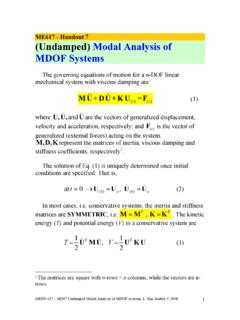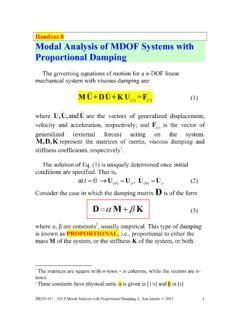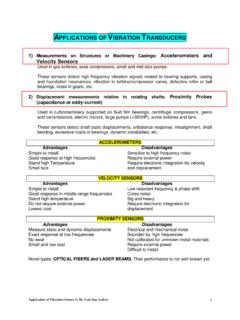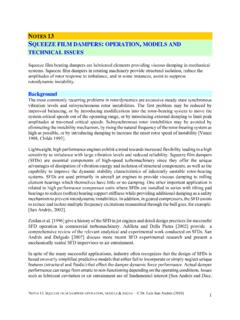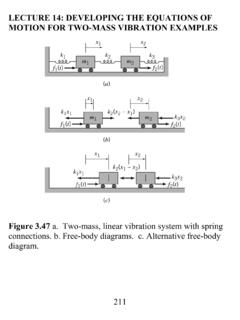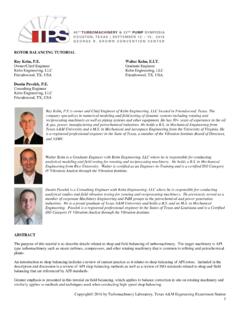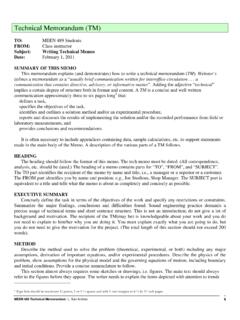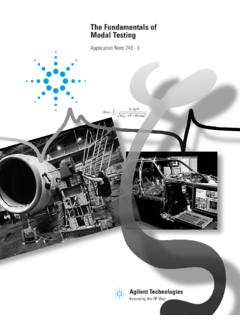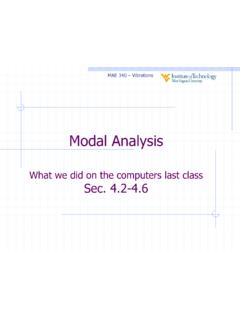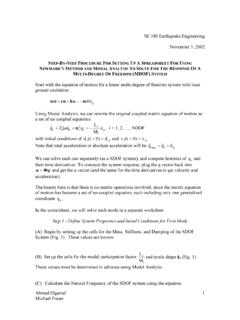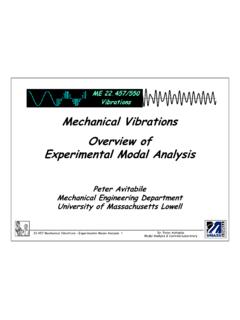Transcription of Modal Analysis of MDOF Systems with Proportional Damping
1 MEEN 617 HD 8 Modal Analysis with Proportional Damping . L. San Andr s 2013 1 Handout 8 Modal Analysis of MDOF Systems with Proportional Damping The governing equations of motion for a n-DOF linear mechanical system with viscous Damping are: ()()ttMU+DU+KU =F (1) where andU, U,U are the vectors of generalized displacement, velocity and acceleration, respectively; and ()tF is the vector of generalized (external forces) acting on the system . M, D, Krepresent the matrices of inertia, viscous Damping and stiffness coefficients, respectively1. The solution of Eq. (1) is uniquely determined once initial conditions are specified.
2 That is, (0)(0)at0,oot UUUU (2) Consider the case in which the Damping matrix D is of the form DM K (3) where , are constants2, usually empirical. This type of Damping is known as Proportional , , Proportional to either the mass M of the system , or the stiffness K of the system , or both. 1 The matrices are square with n-rows = n columns, while the vectors are n-rows. 2 These constants have physical units, is given in [1/s] and in [s] MEEN 617 HD 8 Modal Analysis with Proportional Damping . L. San Andr s 2013 2 Proportional Damping is rather unique, since only one or two parameters (at most), and , appear to fully describe the complexity of Damping , irrespective of the system number of DOFs, n.
3 This is clearly not realistic. Hence, Proportional Damping is not a rule but rather the exception. Nonetheless the approximation of Proportional Damping is useful since, most times, Damping is quite an elusive phenomenon, , difficult to model (predict) and hard to measure but for a few DOFs. Next, consider one already has found the natural frequencies and natural modes (eigenvectors) for the UNDAMPED case, given MU+KU=0 , ()1, ,iiin satisfying 2()1,..,iiin M+K =0. (4) with properties ;TTMK M K (5) As in the undamped Modal Analysis , consider the Modal transformation ()()tt U q (6) And with ()()()();tttt U qU q , then EOM (1) becomes: ()t M q+D qK q=F (7) which offers no advantage in the Analysis .
4 However, premultiply the equation above by T to obtain ()TTTTt M q+ D q K q= F (8) And using the Modal properties, Eq. (5), and MEEN 617 HD 8 Modal Analysis with Proportional Damping . L. San Andr s 2013 3 TTTT D MK M K TMKD D (9) , [D] is a diagonal matrix known as Proportional Modal Damping . Then Eq. (7) becomes ()TtMDK q+qq=Q F (10) Thus, the equations of motion are uncoupled in Modal space, since [M], [D], and [K] are diagonal matrices. Eq. (10) is just a set of n-uncoupled ODEs. That is, (11) Or 1, ,jjjjjjjjnMq Dq Kq Q (12) Where jjjKMn and jjjDM K . Modal Damping ratios are also easily defined as 22jjjjjjjjDMKKMKM ; j=1,2.
5 N (13) For Damping Proportional to mass only, 0 , and MEEN 617 HD 8 Modal Analysis with Proportional Damping . L. San Andr s 2013 422jjjnjjMKM (13a) , the j- Modal Damping ratio decreases as the natural frequency increases. For Damping Proportional to stiffness only, 0 , (structural Damping ) and 22jnjjjjKKM (13b) , the j- Modal Damping ratio increases as the natural frequency increases. In other words, higher modes are increasingly more damped than lower modes. The response for each Modal coordinate satisfying the Modal Eqn. 1, ,jjjjjjj jnMq Dq Kq Q is obtained in the same way as for a single DOF system (See Handout 2).
6 First, find initial values in Modal space ,jjooqq . These follow from either 11;ooo o q Uq U (14) or 11,TooTooMM q MUq MU (15a) ()()11,kkTTokookokkqqMM MU MU (15b) k=1,..n MEEN 617 HD 8 Modal Analysis with Proportional Damping . L. San Andr s 2013 5 Free response in Modal coordinates Without Modal forces, Q=0, the Modal EOM is 0jj jjHjHjHjMqDq KqQ (16) with solution, for an elastic underdamped mode 1j cossinjdjjjjtHjdjdqeCtSt if 0jn (17a) where 21,jjjjjKMdnjn and ;jjjjjojnojo jdqqCq S (17b) See Handout (2a) for formulas for responses corresponding to overdamped and critically damped SDOF Systems . Forced response in Modal coordinates For step-loads, SjQ, the Modal equations are jjjjjjSjMqDq Kq Q (18) with solution, for an elastic underdamped mode 1j cossinjdjjjjjtjdj d SqeCtSt q 0jn (19a) MEEN 617 HD 8 Modal Analysis with Proportional Damping .
7 L. San Andr s 2013 6 where 21,jjjjjKMdnjn and ;;jjjjjjjSojnjSjoSjjdQqCqCqqSK (19b) See Handout (2a) for formulas for physical responses corresponding to overdamped and critically damped SDOF Systems . For periodic-loads, Consider the case of force excitation with frequency jn and acting for very long times. The EOMs in physical space are cost PMU+DU KU=F The Modal equations are cos()jjjjjjjPMqDq KqQt (20) with solutions for an elastic mode, 0jn ()cossincossinjnjjjjjjtransientss ttjdjdcsqqqeC tS tCtCt (21) The steady state or periodic response is of importance, since the transient response will disappear because of the dissipative effects of Damping .
8 Hence, the j-mode response is: MEEN 617 HD 8 Modal Analysis with Proportional Damping . L. San Andr s 2013 7 cosjjPPSj jjQqAtK (22) Let jjnf be a jth-mode excitation frequency ratio. Then, define 222112 jjjjAff and 22tan1jjjjff (23) Recall that j is a phase angle and Aj is an amplitude ratio for the jth-mode. Note that depending on the magnitude of the excitation frequency , the frequency ratio for a particular mode, say k, determines the regime of operation, , below, above or around the natural frequency. Using the mode displacement method, the response in physical coordinates is 1cosjmPjjjjjQAtK U (24) and recall that 2()()jTjnj jjKM K and ()jTPjQ P F.
9 A mode acceleration method can also be easily developed to give (* read addendum) 2112cosjjmmjjjPSPS jjjjtqq SP UU (25) MEEN 617 HD 8 Modal Analysis with Proportional Damping . L. San Andr s 2013 8where 1 SPpUKF. Note that the mode acceleration method cannot be applied if there are any rigid body modes (K is singular) Frequency response functions for damped MDOF Systems . The steady state or periodic Modal response for the j-mode is: cosjjPPSj jjQqAtK (22) Or, taking the real part of the following complex number expression jjPitPSjjQqHeK (26) where 2112 jjjjHfif (27) with 1i is the imaginary unit, and where jjnf is the jth-mode excitation frequency ratio. Then, recall from Eqs.
10 (23) 222112 jjjjjAHff and argjjH (28) Using the Modal transformation, the periodic response UP in physical coordinates is MEEN 617 HD 8 Modal Analysis with Proportional Damping . L. San Andr s 2013 9 1cosjnPjjjjjQAtK PU (24) or take the real part of the equation below 111 TnnjitjjjjjjjnjTitjjjjqHeKHeK PPP FU q F(29) Now, the product ()Tjjnn matrix. That is, define the elements of the complex frequency response matrix H as ,2112 pqTjjpqjjjjHKfi f (30) p,q =1, n. The response in physical coordinates thus becomes: ite PPU=HF (31) or in component form, ,1, ;jrnitPjrPjnrUHFe (32) The components of the frequency response matrix H are determined numerically or experimentally.
